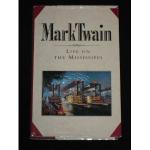I have been speaking of public architecture only. The domestic article in New Orleans is reproachless, notwithstanding it remains as it always was. All the dwellings are of wood—in the American part of the town, I mean—and all have a comfortable look. Those in the wealthy quarter are spacious; painted snow-white usually, and generally have wide verandas, or double-verandas, supported by ornamental columns. These mansions stand in the center of large grounds, and rise, garlanded with roses, out of the midst of swelling masses of shining green foliage and many-colored blossoms. No houses could well be in better harmony with their surroundings, or more pleasing to the eye, or more home-like and comfortable-looking.
One even becomes reconciled to the cistern presently; this is a mighty cask, painted green, and sometimes a couple of stories high, which is propped against the house-corner on stilts. There is a mansion-and-brewery suggestion about the combination which seems very incongruous at first. But the people cannot have wells, and so they take rain-water. Neither can they conveniently have cellars, or graves,{footnote [The Israelites are buried in graves—by permission, I take it, not requirement; but none else, except the destitute, who are buried at public expense. The graves are but three or four feet deep.]} the town being built upon ‘made’ ground; so they do without both, and few of the living complain, and none of the others.
Chapter 42 Hygiene and Sentiment
They bury their dead in vaults, above the ground. These vaults have a resemblance to houses—sometimes to temples; are built of marble, generally; are architecturally graceful and shapely; they face the walks and driveways of the cemetery; and when one moves through the midst of a thousand or so of them and sees their white roofs and gables stretching into the distance on every hand, the phrase ‘city of the dead’ has all at once a meaning to him. Many of the cemeteries are beautiful, and are kept in perfect order. When one goes from the levee or the business streets near it, to a cemetery, he observes to himself that if those people down there would live as neatly while they are alive as they do after they are dead, they would find many advantages in it; and besides, their quarter would be the wonder and admiration of the business world. Fresh flowers, in vases of water, are to be seen at the portals of many of the vaults: placed there by the pious hands of bereaved parents and children, husbands and wives, and renewed daily. A milder form of sorrow finds its inexpensive and lasting remembrancer in the coarse and ugly but indestructible ’immortelle’—which is a wreath or cross or some such emblem, made of rosettes of black linen, with sometimes a yellow rosette at the conjunction of the cross’s bars—kind of sorrowful breast-pin, so to say. The immortelle requires no attention: you just hang it up, and there you are; just leave it alone, it will take care of your grief for you, and keep it in mind better than you can; stands weather first-rate, and lasts like boiler-iron.




